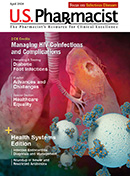The 2017 NCPA Digest notes that the estimated number of independent community pharmacies dropped to 22,041 from last year’s total of 22,160. The annual benchmarking survey sponsored by Cardinal Health and presented at the National Community Pharmacists Association’s annual convention in Orlando also reveals that community pharmacies represent 36% of the retail pharmacy marketplace.
The review, which has been around for eight decades, found not only a trend of increasing scope of services, but also lower reimbursements for filling prescriptions.
“Independent community pharmacies remain indispensable for patients, especially in underserved communities, according to the latest NCPA Digest,” said NCPA CEO B. Douglas Hoey, MBA. “This occurs because of the quality of services, which are growing as pharmacists find new ways to drive better health outcomes for their patients, and through civic engagement in their communities.”
In terms of services provided by community pharmacies, the digest found:
• 86% offer medication therapy management
• 74% provide immunizations
• 61% perform blood pressure monitoring
• 52 % furnish durable medical goods
Looking at the 2016 independent community pharmacy marketplace, the 2017 NCPA digest identified some troubling trends, including the fact that prescription volume decreased from 60,493 prescriptions annually in 2016 to 59,746 in 2017. Review authors suggested that probably is related to 90-day refill requirements, patients being incentivized to use pharmacy benefit manager-owned mail-order pharmacies, and exclusionary pharmacy network arrangements.
At the same time, below-cost reimbursements fueled a more than a 5% decline in gross margins over the past 5 years. Part of the problem, according to the review, was burdensome direct and indirect remuneration (DIR) fees in Medicare Part D.
The report notes that 84% of all drugs filled at community pharmacies are generics, and 52% of all prescriptions are covered Medicare Part D and Medicaid programs.
Yet, community pharmacies are finding a way to survive, which is especially important to smaller communities. The digest states that 81% of community pharmacies serve population areas of 50,000 or less and that the businesses are important to the economies of those areas, employing more than 200,000 full-time equivalent (FTE) staffers.
The nonchain pharmacies also give back to their communities in other ways. The 2017 digest found that nearly 69% of all independent community pharmacy owners donated to at least five local organizations in 2016.






